
Sub-Saharan Africa or Subsahara is the area and regions of the continent of Africa that lie south of the Sahara. These include Central Africa, East Africa, Southern Africa, and West Africa. Geopolitically, in addition to the African countries and territories that are situated fully in that specified region, the term may also include polities that only have part of their territory located in that region, per the definition of the United Nations (UN). This is considered a non-standardised geographical region with the number of countries included varying from 46 to 48 depending on the organisation describing the region. The African Union (AU) uses a different regional breakdown, recognising all 55 member states on the continent—grouping them into five distinct and standard regions.
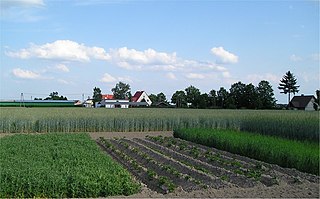
Crop rotation is the practice of growing a series of different types of crops in the same area across a sequence of growing seasons. This practice reduces the reliance of crops on one set of nutrients, pest and weed pressure, along with the probability of developing resistant pests and weeds.

Vermicompost (vermi-compost) is the product of the decomposition process using various species of worms, usually red wigglers, white worms, and other earthworms, to create a mixture of decomposing vegetable or food waste, bedding materials, and vermicast. This process is called vermicomposting, with the rearing of worms for this purpose is called vermiculture.
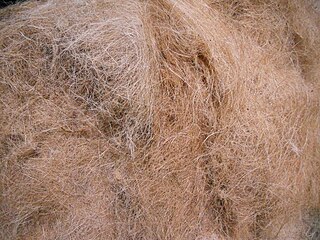
Coir, also called coconut fibre, is a natural fibre extracted from the outer husk of coconut, and used in products such as floor mats, doormats, brushes, and mattresses. Coir is the fibrous material found between the hard, internal shell and the outer coat of a coconut. Other uses of brown coir are in upholstery padding, sacking and horticulture. White coir, harvested from unripe coconuts, is used for making finer brushes, string, rope and fishing nets. It has the advantage of not sinking, so can be used in long lengths in deep water without the added weight dragging down boats and buoys.
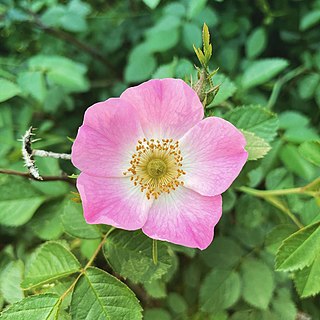
Rosa rubiginosa is a species of rose native to Europe and western Asia.

Invasive species in Australia are a serious threat to the native biodiversity, and an ongoing cost to Australian agriculture. Numerous species arrived with European maritime exploration and colonisation of Australia and steadily since then. There is much ongoing debate about the potential benefits and detriments of introduced species; some experts believe that certain species, particularly megafauna such as deer, equids, bovids, and camels, may be more beneficial to Australia's ecosystems than they are detrimental, acting as replacements for extinct Australian megafauna.
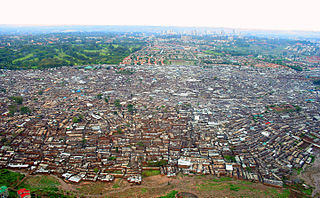
Poverty in Africa is the lack of provision to satisfy the basic human needs of certain people in Africa. African nations typically fall toward the bottom of any list measuring small size economic activity, such as income per capita or GDP per capita, despite a wealth of natural resources. In 2009, 22 of 24 nations identified as having "Low Human Development" on the United Nations' (UN) Human Development Index were in Sub-Saharan Africa. As of 2019, 424 million people in sub-Saharan Africa were reportedly living in severe poverty. In 2022, 460 million people—an increase of 36 million in only three years—were anticipated to be living in extreme poverty as a result of the COVID-19 pandemic and the Russo-Ukrainian war.
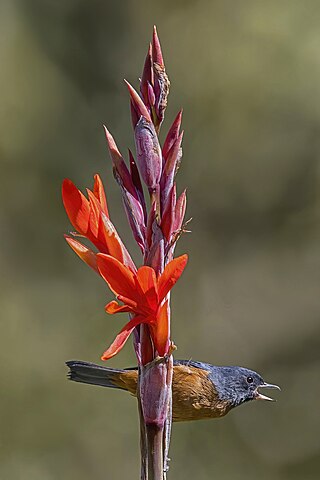
Canna indica, commonly known as Indian shot, African arrowroot, edible canna, purple arrowroot, Sierra Leone arrowroot, is a plant species in the family Cannaceae. It is native to much of South America, Central America, the West Indies, and Mexico. It is also naturalized in the southeastern United States, and much of Europe, sub-Saharan Africa, Southeast Asia, and Oceania.

The population of Africa has grown rapidly over the past century and consequently shows a large youth bulge, further reinforced by increasing life expectancy in most African countries. Total population as of 2024 is about 1.5 billion, with a growth rate of about 100 million every three years. The total fertility rate for Africa is 4.1 as of 2024, the highest in the world. The most populous African country is Nigeria with over 206 million inhabitants as of 2020 and a growth rate of 2.6% p.a.

Pontederia crassipes, commonly known as common water hyacinth, is an aquatic plant native to South America, naturalized throughout the world, and often invasive outside its native range. It is the sole species of the subgenus Oshunae within the genus Pontederia. Anecdotally, it is known as the "terror of Bengal" due to its invasive growth tendencies.

Zero waste agriculture is a type of sustainable agriculture which optimizes use of the five natural kingdoms, i.e. plants, animals, bacteria, fungi and algae, to produce biodiverse-food, energy and nutrients in a synergistic integrated cycle of profit making processes where the waste of each process becomes the feedstock for another process.

Cleome gynandra is a species of Cleome that is used as a leaf vegetable. It is known by many common names including Shona cabbage, African cabbage, spiderwisp, cat's whiskers, and stinkweed. It is an annual wildflower native to Africa but has become widespread in many tropical and sub-tropical parts of the world.

Agricultural sustainability in Northern Nigeria requires flexibility in both ecological management as well as economic activity. The population densities of the rural area in this region climbed from 243 to 348 people per square kilometer between 1962 and 1991, but the land area under permanent cultivation remained approximately the same. Increasing population results in high food demand among urban and rural dwellers, areas of cultivation, and reduced soil fertility. However, there are instances where frequent agricultural practices is not associated with degradation such as in Kano and neighboring region. Even though poverty and insufficient food exists in the region, it does not affect crop yield owing to sustained efforts to produce food in response to its high demand.
Energy use and development in Africa varies widely across the continent, with some African countries exporting energy to neighbors or the global market, while others lack even basic infrastructures or systems to acquire energy. The World Bank has declared 32 of the 48 nations on the continent to be in an energy crisis. Energy development has not kept pace with rising demand in developing regions, placing a large strain on the continent's existing resources over the first decade of the new century. From 2001 to 2005, GDP for over half of the countries in Sub Saharan Africa rose by over 4.5% annually, while generation capacity grew at a rate of 1.2%.
Johnson Donatus Aihumekeokhai Ojeikere, known as J.D. 'Okhai Ojeikere, was a Nigerian photographer known for his work with unique hairstyles found in Nigeria.

An aquatic weed harvester, also known as a water mower, mowing boat and weed cutting boat, is an aquatic machine specifically designed for inland watercourse management to cut and harvest underwater weeds, reeds and other aquatic plant life. The action of removing aquatic plant life in such a manner has been referred to as "aquatic harvesting".

Cassava production is vital to the economy of Nigeria as the country is the world's largest producer of the commodity. The crop is produced in 24 of the country's 36 states. In 1999, Nigeria produced 33 million tonnes, while a decade later, it produced approximately 45 million tonnes, which is almost 19% of production in the world. The average yield per hectare is 10.6 tonnes.

Bilikiss Adebiyi or Bilikiss Adebiyi-Abiola is a Nigerian entrepreneur who founded the Lagos-based recycling company 'Wecyclers'. In 2022 she was the Director General of the Lagos State Records and Archives Bureau (LASRAB) and Managing Director of the Lagos State Parks and Gardens Agency (LASPARK). She was a member of the Board of Trustees of the Lagos State Employment Trust Fund.
Diana Jue-Rajasingh is an American female activist who is promoting life-improving technologies in South India. She has established the Essmart network in association with Jackie Stenson, whom she met while at MIT, to disseminate technology innovations which are largely unknown in the rural areas of India and China. Through this network of community initiatives she and her friend created distribution channels. In 2015, Forbes named Jue-Rajasingh as "one of Forbes' 30 under 30." In 2016, Jue-Rajasingh entered the Strategy doctoral program at the University of Michigan Ross School of Business.

Wecyclers is a waste management company in Nigeria that helps low-income communities exchange their recyclable waste which is measured in kilograms for cash and other rewards.

















